Selecting an apt pair of hiking boots is a nuanced task that demands careful consideration, as such footwear serves as the critical interface between the hiker and the rugged terrain. While most hikers recognize the importance of a well-fitted boot, the criteria for what constitutes 'well-fitted' is often nebulous and overlooked.
The fit of your hiking boots not only dictates your comfort during the hike but can also significantly influence your safety and performance on the trail. As such, we will be discussing ten crucial factors to consider when choosing your hiking boots, beginning with understanding boot sizes to debating the necessity of waterproof hiking boots.
Key Takeaways
- Proper sizing is crucial for comfort and performance in hiking boots.
- Consider foot shape, arch support, and foot volume when selecting hiking boots.
- Gradually break in and maintain boots to ensure durability and prevent discomfort.
- Debating the pros and cons of waterproof hiking boots can help make an informed decision based on specific needs and conditions.
Understanding Hiking Boot Sizes
In the realm of hiking, comprehending the intricacies of boot sizes is crucial, as it requires not only measuring the length and width of your foot, but also taking into account the shape of your foot, potential swelling, the thickness of your socks, and the specific conditions under which the boots will be used. Thus, understanding hiking boot sizes is a pivotal step towards ensuring your hiking boots fit properly.
To measure your feet, one must take into consideration not just the length, but also the width. However, the process of sizing doesn't end there. The shape of your foot, any specific foot concerns, and the possibility of foot swelling during long hikes must also be considered. This is where the right fit becomes paramount. Boots that fit your feet correctly can significantly enhance the hiking experience, reducing discomfort and preventing injuries.
The types of hiking boots available, too, can influence size selection. Different boots are designed for different terrains and uses; hence, choosing the right size based on your specific hiking type is essential. Furthermore, the thickness of your socks can also impact the boot's fit, making it necessary to try on boots with your intended hiking socks.
Importance of Foot Measurements
Having underscored the intricacies involved in understanding hiking boot sizes, it's equally critical to highlight why meticulous foot measurements play a pivotal role in this process. The importance of foot measurements cannot be overstated when deciding how should hiking boots fit.
Accurate foot measurements, which include both the length and width of the foot, are the cornerstone to selecting the right size of hiking boots.
To choose hiking boots that provide comfort and prevent blisters or other foot problems, one must measure the length of their foot meticulously. However, it's not just about the length. The width is equally important since it ensures the boot isn't too tight or too loose, both of which could lead to discomfort or injury.
Moreover, foot measurements take into account factors such as foot swelling and the thickness of your hiking socks. This ensures a comfortable fit, even in challenging conditions. A Brannock device, a standard tool for measuring foot size, can be extremely useful in this regard.
Sizing Up: A Necessary Step
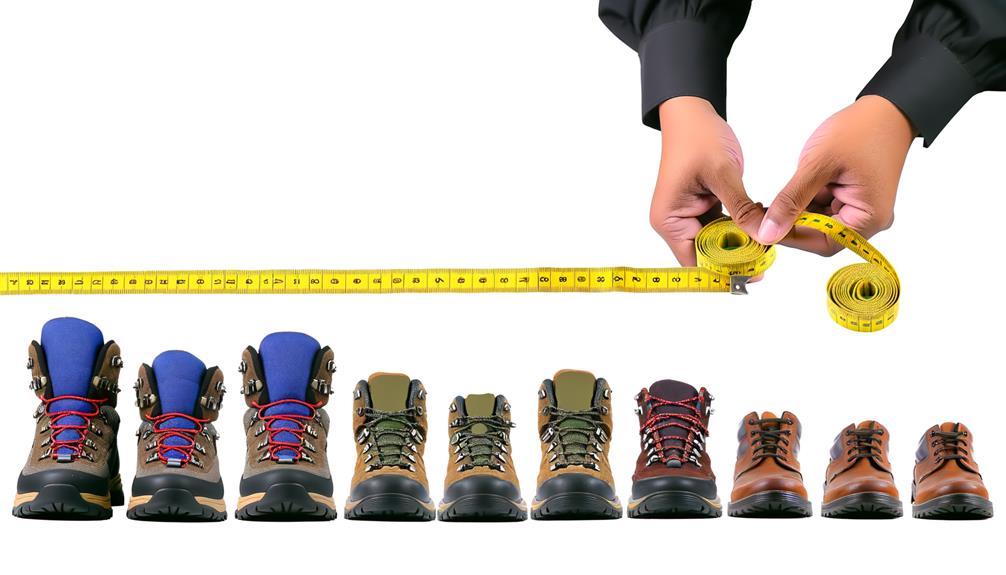
Proper sizing is a critical step in the process of selecting hiking boots, requiring careful consideration for ensuring comfort, safety, and performance on various trail conditions. Consider the largest size your foot could possibly be during a hike, taking into account swelling due to physical exertion.
- Fit: The hiking boots should have a proper fit; snug, but not too tight. There should be room at the end of the shoe for your toes to wiggle, but your foot should not slide forward when you walk. The heel cup should hold your heel securely to prevent blisters.
- Ankle Support: Check for proper ankle support. This is crucial for stability on uneven terrain. The boot should grip your ankle tightly, but without causing discomfort.
- Adjustments: Laces and straps should be adjustable to secure a comfortable fit. They should hold your foot firmly in place without creating pressure points.
Sizing up is a necessary step to find the perfect hiking boots. To sum up, an ideal boot is one that offers a balance between comfort and support. Remember, a successful hike depends largely on the boots you wear. Choose wisely.
The Art of Lacing Hiking Boots
Mastering the art of lacing hiking boots is an often overlooked but crucial aspect of optimizing both comfort and function during your outdoor adventures. This involves more than just tying a knot; it's about creating a secure base, locking the heel in place, and relieving pressure on the top of your foot.
Start with a Surgeon's Knot for a secure fit, particularly beneficial for those with narrow feet or slippery laces. A Lace Lock at the ankle can prevent heel slippage, ensuring the right footwear doesn't become a hindrance when you're negotiating tricky terrains. Window Lacing is a practical way to alleviate pressure on the top of your foot or accommodate a high instep.
Enhancing the support offered by your hiking boots is essential, and this can be achieved with Heel Lock Lacing. This technique also prevents heel lift, contributing to the overall fit of the hiking footwear.
Identifying the Perfect Fit
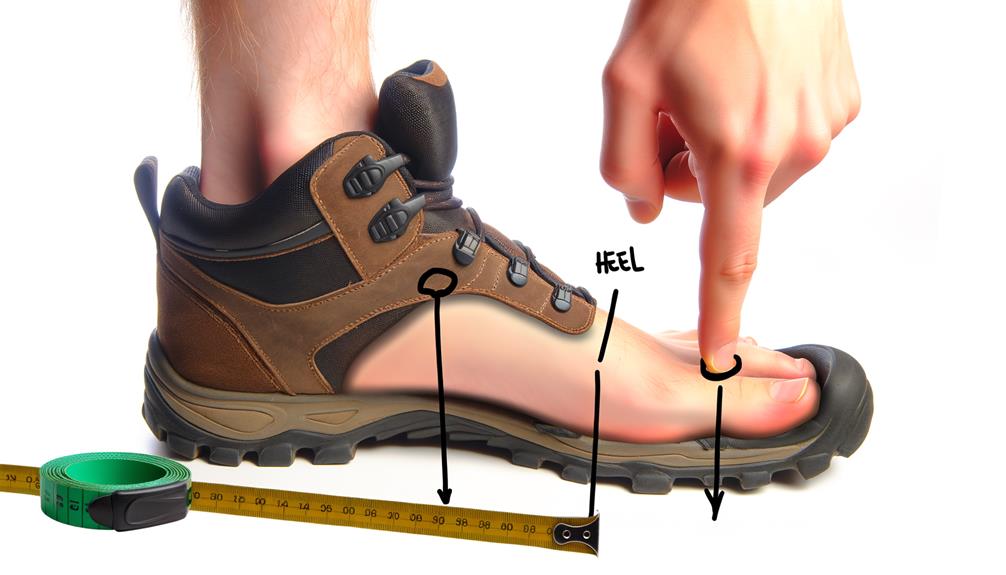
In the quest for the perfect hiking boots, understanding your foot shape is an essential first step; this knowledge allows you to select a design that accommodates your unique needs.
The importance of sizing cannot be overstated, as a correctly-sized boot offers the necessary room for your foot, and accounts for swelling that can occur during long hikes.
Lastly, consideration for the thickness of your hiking socks is crucial, as this factor can significantly impact the fit and comfort of the boot.
Understanding Your Foot Shape
Understanding the unique intricacies of your foot shape is a critical step in identifying the perfect fit for your hiking boots. This understanding is instrumental in ensuring comfort, stability, and durability in the field.
- Foot Shape: The shape of your feet tend to vary widely. Some people have narrow, some wide, and others neutral arches. The best fit for your hiking boots will be determined by these variations.
- Arch Support: The arch support in hiking shoes is crucial. It provides the necessary balance and reduces the risk of foot fatigue and injuries.
- Volume: Low, medium, or high foot volume affects boot fit significantly. It's essential to choose a boot that corresponds to your foot volume to ensure a comfortable and secure fit.
Importance of Correct Size
Navigating the terrain of hiking boot sizes is a crucial endeavor, as an imperfect fit can lead to discomfort, soreness, and even injuries during your outdoor adventures. The importance of correct size cannot be overstated when it comes to how hiking boots should fit.
A correct size means the boots fit well, providing adequate ankle support and space for when your feet swell on long hikes. Boots too tight can cause blisters, while too loose can result in instability.
To choose hiking boots of the correct size, try on multiple pairs, walk around in them, and ensure they offer comfort and support. Remember, the right fit significantly enhances your hiking experience, underlining the importance of correct size.
Adjusting for Sock Thickness
While the importance of selecting the correct boot size is undisputed, another crucial factor in identifying the perfect fit for your hiking boots is adjusting for the thickness of your hiking socks. This adjustment can make significant differences in comfort and functionality.
Sock Selection: Choose the socks you'll be hiking in before trying on boots. Thicker socks provide extra cushioning but may require you to go up half a size in your boots.
Boot Fitting: Ensure your hiking boots can comfortably accommodate your feet along with the sock thickness. Too tight a fit can result in discomfort and blisters.
Adjustment: Make necessary adjustments to laces and straps for a snug fit without constriction. Remember, your feet may swell during long hikes, requiring extra room.
Adjusting for sock thickness is an essential step towards an enjoyable hiking experience.
The Toe-Tap Test for Boots
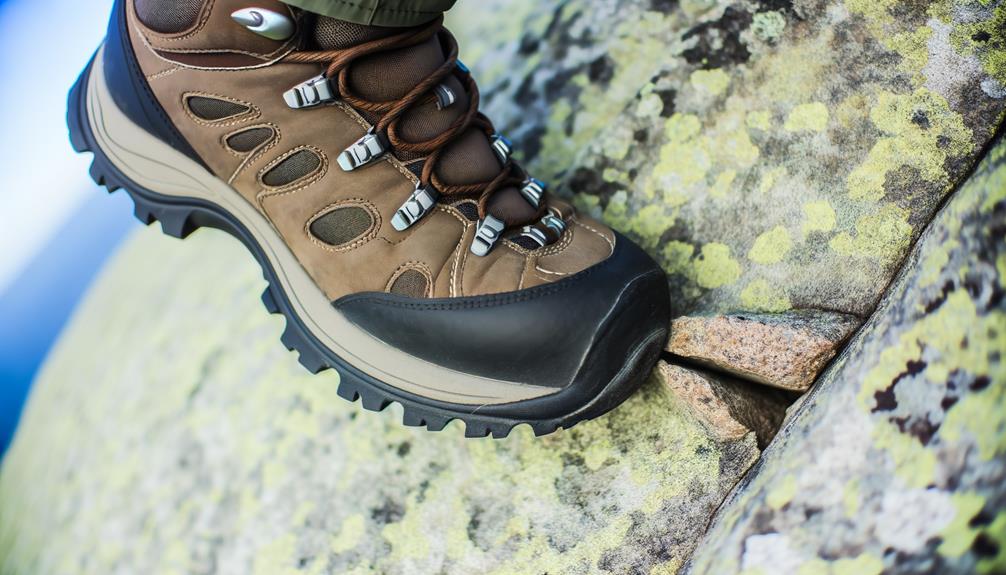
One noteworthy method for assessing the fit and comfort of hiking boots is the toe-tap test for boots, a simple procedure that involves tapping the front of the boot against the ground to ensure there is ample space for your toes to move and wiggle comfortably. When carrying out this test, it's important to make sure that the boots feel snug without causing any discomfort.
The toe-tap test is not only beneficial for assessing the initial fit of the boots, but also serves as a reliable method to evaluate comfort and mobility over time, helping to identify any potential heel slippage. It's essential to have roughly an inch of space in the front of the boot to accommodate toe movement, crucial for the hiker to maintain balance and stability on challenging terrains.
Performing the toe-tap test with the designated hiking socks is key to ensure an accurate fit. Breaking in boots slowly, repeating this test over time, reinforces the boot's adaptability to the foot's shape, enhancing the hiking experience. This methodical approach, part of the 108 essential steps in choosing the right hiking boots, assures both comfort and safety, fostering a sense of belonging among the hiking community.
Observing Foot Movement
Observing foot movement in a hiking boot is crucial to ensure a proper fit and prevent potential injuries.
This includes understanding your natural gait and the importance of arch support, as well as assessing the freedom of heel and toe movement.
These factors are key in determining comfort, stability, and overall performance of the boot during hikes.
Understanding Natural Gait
To fully comprehend the importance of choosing the right hiking boots, it is crucial to first understand how your foot naturally moves, or your 'natural gait', during walking. It's about getting to know the unique way in which you shift your weight from heel to toe, and how your boot can support this movement.
- Heel Lift: Pay attention to how your foot lands and rolls. A boot that complements this movement can prevent blisters and plantar fasciitis.
- Support and Protection: Your boots should provide stability and comfort. This becomes particularly important when the terrain alters your natural gait.
- Understanding Natural Gait: Always select boots that match your natural foot movement, offering both flexibility and support. This knowledge helps to prevent discomfort and potential injuries.
Importance of Arch Support
Undoubtedly, the aspect of arch support plays a pivotal role in the selection of hiking boots, as it is integral to comfortable and efficient foot movement, particularly when traversing rugged terrains.
The importance of arch support cannot be overstated, as it provides the support you need by holding your foot securely and mitigating pressure points. Heavy-duty hiking boots with stiffer mid-soles are recommended as they provide superior arch support, ensuring minimized foot fatigue.
Observing foot movement can reveal insufficient arch support, such as overpronation, a common cause of blisters and foot pain. Arch support also facilitates shock absorption, evenly distributing pressure and maintaining proper foot alignment.
This support is crucial for those desiring belonging within the hiking community, promoting comfort and endurance.
Heel and Toe Movement
In the realm of hiking boot selection, a key factor to consider is the movement of the heel and toes within the boot, which can significantly influence comfort and performance during hikes.
- Heel Movement: Your heel should stay firmly in place without lifting when you walk around inside the hiking shoe. A heel that slips can lead to discomfort, blisters, and a reduced level of support on rough terrain.
- Toe Comfort: Ensure your longest toe has enough room to wiggle without hitting the front of the boots inside. Any rubbing indicates a poor fit and can cause pain or injury.
- Foot Flexibility: Observe how your foot flexes and moves within the boot, especially on inclines or uneven surfaces. Minimizing excess heel and toe movement will optimize your hiking experience.
Breaking in Your Boots
Before embarking on long hiking adventures, it is essential to gradually break in your new hiking boots to ensure comfort and prevent potential injuries. Buying hiking boots is just the first step in your journey. To properly break in your boots, start by wearing them around the house. This will allow your feet to adapt to the shoes and boots without the harsh conditions of the trail.
If you've invested in leather boots, consider applying a leather conditioner. This softens the material, making the breaking in process smoother. Remember to remove any dirt before applying the conditioner to avoid damaging the leather.
Keep in mind the importance of appropriate socks. Thicker hiking socks simulate the conditions of hiking, aiding in breaking in your boots. Gradually extend the duration and difficulty of your hikes as your boots become more comfortable.
To help you remember these steps, here's a table:
| Step | Action | Purpose |
|---|---|---|
| 1 | Wear them around | Adaptation |
| 2 | Apply leather conditioner | Soften leather boots |
| 3 | Use thick socks | Simulate hiking conditions |
| 4 | Gradually increase hikes | Comfort enhancement |
| 5 | Check for discomfort | Prevent injuries |
Importance of Hiking Socks
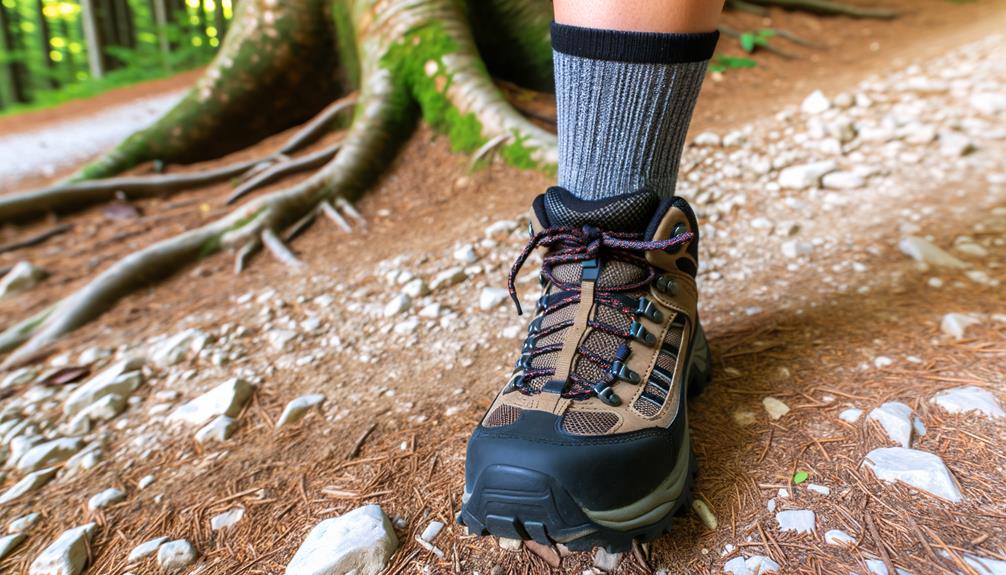
As we venture deeper into the realm of hiking essentials, the significance of hiking socks cannot be overstated, playing a pivotal role in providing cushioning, moisture-wicking, and blister prevention during hikes. The importance of hiking socks extends even to the fit of your shoe or boot. A well-chosen pair can enhance comfort, impact foot health positively, and increase your stamina on long treks.
- Type of Hiking Socks: Selecting the suitable sock based on the type of hiking, weather conditions, and terrain can significantly elevate your hiking experience. A good rule of thumb is to have at least two pairs for rotation.
- Material: Wool socks are excellent for their ability to regulate foot temperature and deliver superior moisture-wicking properties. They also help prevent the formation of blisters and hot spots.
- Layering: Wearing two pairs of socks, with a thin liner as the base and a thicker sock as the top layer, can provide additional cushioning and reduce friction, further preventing blisters.
Debating Waterproof Hiking Boots
As we progress in our discussion on choosing the right hiking boots, it is crucial to consider the debate surrounding waterproof options.
Waterproof boots, while highly efficient in wet conditions, may not always be the best choice due to certain disadvantages like prolonged drying time and potential blister risk.
On the other hand, non-waterproof boots, due to their lightweight nature and quick-drying ability, may be more suited for warmer climates and dry terrains.
Pros of Waterproof Boots
Undeniably, waterproof hiking boots offer considerable advantages, particularly in terms of providing protection from wet and rainy conditions during treks. They are designed to keep your feet dry, making them not only comfortable but also reducing the risk of blisters, a common problem for hikers.
- Versatility: Waterproof hiking boots are right for diverse terrains and weather conditions, increasing their usefulness for any backpacking trip.
- Comfort and Safety: These boots keep your feet dry, minimizing discomfort and the incidence of blisters.
- Warmth: The pros of waterproof boots extend beyond keeping feet dry. They provide additional warmth, which is crucial in colder environments.
Potential Waterproof Boot Downsides
While waterproof hiking boots offer numerous benefits, it is important to consider potential downsides such as their longer drying time, decreased breathability, heavier weight, and higher cost.
What you Need To Know is that once wet, these boots can take an extended period to dry, which could make a big difference on long backpacking trips.
Their design, while excellent for keeping water out, is not as breathable, leading to potential discomfort on the trail.
Furthermore, these boots are heavier, which may add to fatigue when you hit the trails.
Bear in mind the type of terrain as well, as waterproof boots are designed to provide optimal performance in specific conditions, but may not be as versatile as their non-waterproof counterparts.
Frequently Asked Questions
How Should Your Hiking Boots Fit?
Hiking boots should fit comfortably, providing ample ankle support and insole comfort. Durable boot materials ensure longevity, while weather resistance and proper ventilation contribute to overall comfort. Consider breaking-in time for optimal fit.
Should Hiking Boots Be 1 Size Bigger?
Hiking boots should indeed be one size larger to accommodate for foot expansion, sock thickness, and temperature impacts. Material considerations, boot durability, lacing techniques, and brand differences also play a role in achieving a proper fit.
Should Hiking Boots Be Snug or Loose?
Hiking boots should be snug for effective ankle support and grip, not loose. The boot material, lacing techniques, break in period, breathability and waterproofing quality also significantly affect the overall fit and comfort.
What Are the Tips for Selecting the Best Hiking Boots for Rough Terrain?
For rough terrain, prioritize hiking boots with exceptional terrain adaptability, robust durability, strong ankle support, water resistance, high sole traction and breathability. Also, consider crampon compatibility for icy conditions. Suitable boots can transform precarious paths into thrilling treks.
Conclusion
In conclusion, the pursuit of the impeccable fit in hiking boots is fundamental for a comfortable and safe hiking experience. The artistry of lacing, meticulous foot measurements, and the strategic sizing up are all paramount.
The necessity to observe foot movement, the break-in period, and the importance of hiking socks are not to be undermined. Waterproofing considerations further complicate the selection process.
Thus, achieving the perfect fit in hiking boots is a complex, yet essential endeavor, demanding careful consideration and precise execution.

With years of extensive experience, I specialize in evaluating waterproof hiking shoe options across various brands. My goal is to offer valuable insights and recommendations, enhancing your hiking experience with tips and suggestions for a more adventurous and comfortable journey.

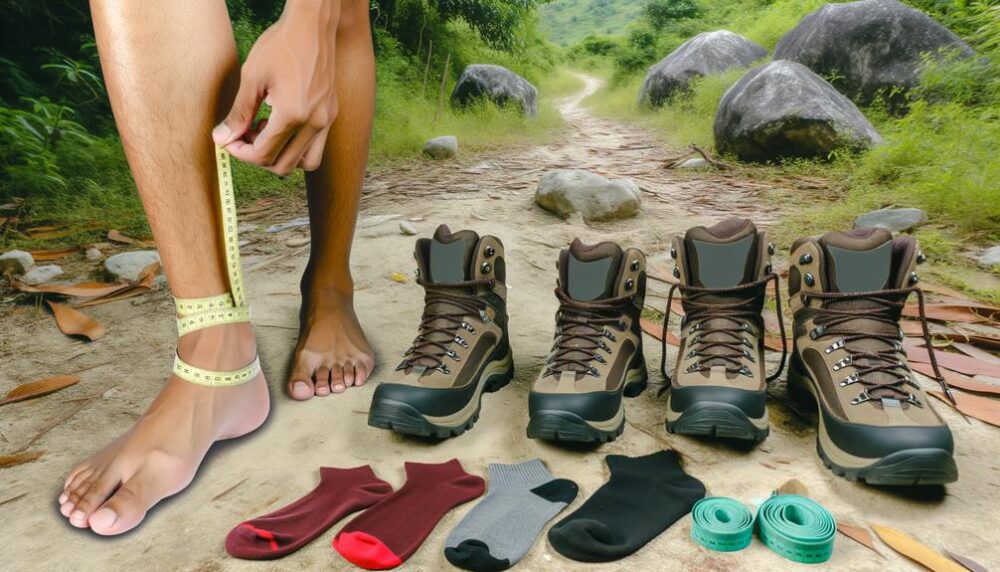
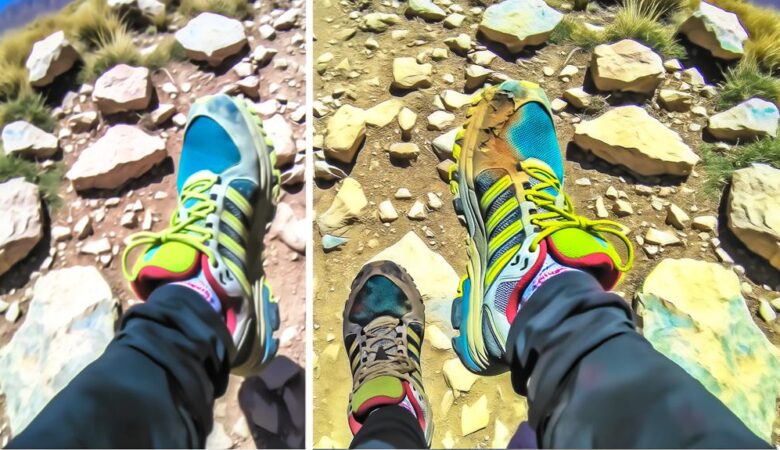



Leave a Reply